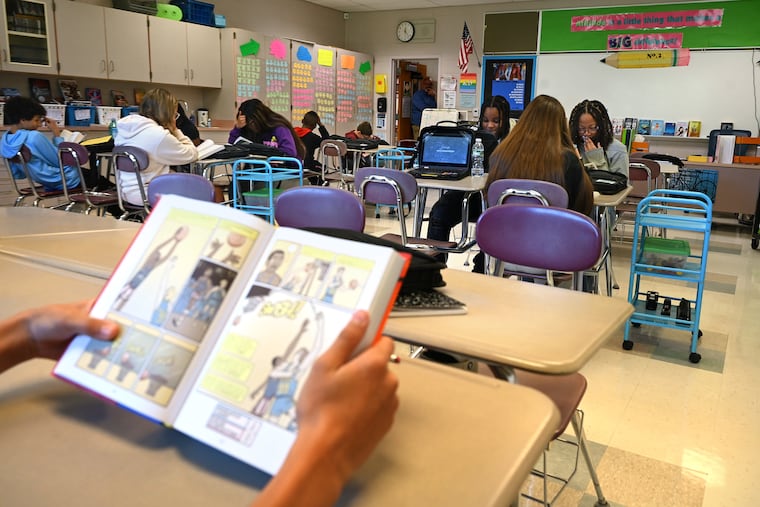Here’s how Pa. school funding impacts salaries, resources, and certification: 5 takeaways from a new study
A new analysis finds that Pennsylvania’s system provides fewer resources to the students most in need of them.

Pennsylvania’s school-funding system — already judged unconstitutional by a state court — affects students in nearly every way: Kids in the state’s lowest-funded districts have less access to strong teachers, counselors, and libraries. Their schools also significantly spend less per pupil on teacher salaries, according to a new analysis.
Pennsylvania’s “current system of funding provides fewer human and fiscal resources to the children who need access to human and fiscal resources the most,” Ed Fuller, a professor in Pennsylvania State University’s education policy studies department, wrote in a new policy brief. “These children tend to be disproportionately children of color and children in poverty.”
Here are some takeaways from the report:
Wealthier school systems have fewer new and uncertified educators
Schools in the lowest-funded districts (locally, Norristown, Chester-Upland, Southeast Delco, Upper Darby, William Penn, and Philadelphia) had higher percentages of teachers new to the profession, those without certification, and those teaching subjects outside of their area of specialty across the board — in elementary, middle, and high schools.
Teacher quality is the biggest determinant of student success, research says, and there’s generally a relationship between a teacher’s years of experience and student outcomes. In elementary schools, 9.2% of teachers in the highest-wealth districts were considered novices, with three years of experience or less; it was 12.6% for the lowest-wealth districts. At the middle school level, the gap was greater — 7.7% for the highest-wealth districts, and 17.2% for the lowest-wealth systems. In high school, 6.9% of teachers in the richest districts were novices, and 13.2% in the poorest.
The numbers tracked the same way for teacher and administrator turnover, Fuller found.
Full-time counselors are scarcer in low-wealth districts, librarians even more so
Data reveals gaps in students’ ability to connect with school counselors, librarians, and more.
Nearly 84% of elementary schools in the wealthiest districts have full-time counselors, compared with nearly 67% of schools in the lowest-wealth districts, for instance.
The differences in who has certified school librarians is particularly stark. At the middle school level, 83.7% of middle schoolers in the best-resourced districts had librarians, and just 14.7% of kids in low-wealth districts.
(Philadelphia’s numbers, experts say, may be the lowest in the nation, with librarian numbers in the single digits.)
Gaps in teacher pay by school can be as wide as $1 million
How much districts have to spend on education affects teacher salaries significantly, data shows.
Measuring per-pupil expenditures, there’s a $1,292 gap between how much elementary school teachers are paid in the highest- and lowest-wealth districts across the state, a $1,318 gap in middle school teacher salaries, and a $1,837 gap in high school teacher salaries.
Fuller examined districts’ outlay on teacher salaries per classroom, too, using per-pupil expenditures (assuming elementary classrooms have 20 students, middle schools have 25 students, and high school classrooms have 30 students). He found that elementary schools in the highest-wealth districts were able to spend $29,000 more per classroom on elementary school teacher salaries, nearly $33,000 per classroom on middle school teacher salaries, and just over $56,000 on high school teacher salaries.
Extrapolated at the school level, that means a difference of about $646,000 at the elementary school level, and $988,000 and $1,870,000 at the middle school and high school levels, according to Fuller’s calculations.
Worst-funded districts have higher percentages of English language learners
Unsurprisingly, the student populations of the highest- and lowest-funded school systems differ significantly.
The worst-funded districts have percentages of Black, Hispanic, economically disadvantaged, and English language learner students that are at least twice the rate of the highest-funded districts. The wealthiest districts have 1.5 times the percentage of white students.
The Philadelphia area has more highest-funded districts than lowest-funded
In the Philadelphia metro area, the 34 districts in the best-funded quintile in the state are: Centennial, Central Bucks, Council Rock, New Hope-Solebury, Palisades, Pennsbury, Abington, Cheltenham, Colonial, Hatboro-Horsham, Jenkintown, Lower Merion, Lower Moreland, Methacton, North Penn, Perkiomen Valley, Souderton Area, Springfield Township, Spring-Ford, Upper Dublin, Upper Merion, Wissahickon, Great Valley, Octorora, Owen J. Roberts, Phoenixville, Tredyffrin/Easttown, Unionville-Chadds Ford, Chichester, Garnet Valley, Marple Newtown, Radnor, Rose Tree Media, and Wallingford-Swarthmore.
The six local districts in the lowest-funded quintile are: Norristown, Chester-Upland, Southeast Delco, Upper Darby, William Penn, and Philadelphia.